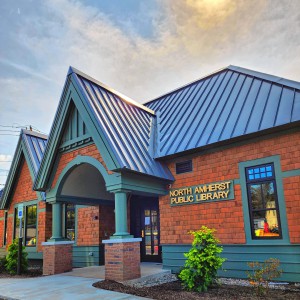Speaking of Nature: Late summer nights a katydid heaven: Warm temperatures, high humidity levels create the perfect conditions for nighttime insects
| Published: 09-12-2023 10:44 PM |
It was the first full week of September and for some reason the weather gods decided to save some of the hottest days of the summer for those of us going back to school. The combination of heat and humidity made the notion of relaxing on the deck after work a rather unattractive notion, so I (perhaps like many of you who don’t have a pool) retreated to the air conditioned confines of my home. It was just a little too hot and sticky to want to play outside.
Even the nighttime temperatures were warm; regularly dipping down to just below 70 degrees Fahrenheit. There seemed little respite from the heat, but I would open the windows nonetheless just to cool things down as much as possible. In the middle of last week I found myself awake and walking around well before dawn and I decided to step outside and take a quick look for meteors before going back to bed. I was instantly rewarded for this decision.
The warm temperatures and high humidity levels had created the perfect conditions for nighttime insects. The various species of crickets in my yard were signing like crazy, but the unmistakable stars of that early-morning performance were most certainly the katydids. Rising loudly above the cacophony of other chirping and trilling sounds were the strong, ”kay-tee-didkay-tee-did” notes of the common true katydid (Pterophyllacamellifolia). The males were singing their love songs in the euphoria of the most sultry summer nights that we have experienced this year.
But the most interesting thing about that entire experience, the exquisite songs of the true katydids notwithstanding, was the quality of that cacophony in the background. In my personal library I possess a wonderful book titled, “Night-singing Insects of the Northeast” by John Himmelman. One of the things that makes this book so interesting is the fact that it actually came with a CD (remember those?) and there are over 70 different songs that you can listen to. Surprisingly, about 10 of them are the songs of different types of katydids. Who knew there were that many?
Well, in addition to being a Bird Nerd (a fun term because it rhymes) I am also a general all-around Nature Nerd (a fun term because of the alliteration). So, it should come as no surprise that I listen to these recordings every summer in the hopes of identifying all of the songs that I hear in late summer.
One song that I heard was the raspy, ”skritch-it” that I have learned belongs to the oblong-winged katydid (Amblycoryphaoblongifolia) and this came as no surprise since I had actually seen one of these gorgeous insects the week prior.
I was returning home after yet another successful morning in the Thinking Chair and I decided to water the potted plants before I went inside for breakfast. A large urn filled with an even larger geranium was first to be watered and I almost instantly noticed that one of the leaves had somehow broken off the plant. These things happen sometimes, so I wasn’t too alarmed. Then the leaf started moving.
It was actually a female oblong-winged katydid that had randomly ended up in the plant and been alarmed by the sudden shower. I would never have noticed her because her coloration so perfectly matched the color of the leaves, but she happened to find herself on the deck boards, which were a light tan, the color of beach sand. On a background like that, there was no hiding and I instantly devised a plan.
Article continues after...
Yesterday's Most Read Articles
 Northampton bans auto dealerships near downtown; zone change won’t affect Volvo operation on King Street
Northampton bans auto dealerships near downtown; zone change won’t affect Volvo operation on King Street
 Proposed Hatfield pickleball/tennis building raising eyebrows
Proposed Hatfield pickleball/tennis building raising eyebrows
 South Hadley man killed in I-91 crash
South Hadley man killed in I-91 crash
 ‘Home away from home’: North Amherst Library officially dedicated, as anonymous donor of $1.7M revealed
‘Home away from home’: North Amherst Library officially dedicated, as anonymous donor of $1.7M revealed
 Police respond to alcohol-fueled incidents in Amherst
Police respond to alcohol-fueled incidents in Amherst
 Public gets a look at progress on Northampton Resilience Hub
Public gets a look at progress on Northampton Resilience Hub
I abandoned my watering and went in to get my camera. Off came the big birding lens and on went the special close-up lens. Then, with the greatest of care, I pinched her long wings between my thumb and index finger and lifted her up to the leaves of a lilac bush that is growing right next to my deck. She was not injured in any way and settled down quite quickly, even taking the time to do a little grooming while I had the luxury of photographing her while she sat on a leaf at my eye level. That almost never happens.
Seen in today’s photograph are the delicate antennae that rise like filaments from the forehead of the insect. We can see the exaggerated hind legs with their sharp spines protruding from the length of the tibia and we note the stunning leaf-life appearance of this katydid’s “tegmen.” On a butterfly this would be called a forewing, while on a beetle this would be called a “elytra.” The katydids do not use the tegmina for flight, but rather for camouflage and as protection for the delicate hindwings that they cover.
Finally, I draw your attention to the curved structure protruding from the end of the katydid’s abdomen. This is a structure called an “ovipositor” and its presence identifies this particular individual as a female. She will use this structure to saw her way into plant tissues, where she will then deposit her eggs, or “ova.” Hence the term “ovipositor.” I was extremely lucky to see this particular katydid under such wonderful photography conditions; the cloudy sky allowing for delectable details, including drops of water still clinging to her.
I have no doubt that anyone who stepped outside last week was able to hear the katydids singing.
Everyone at work was talking about how loud and “happy” the insects were and genuinely enjoying the last great musical performance of the summer. In just a month it will all start to quiet down, so make sure you get outside and take a listen while you can. I guarantee that you will enjoy it.
Bill Danielson has been a professional writer and nature photographer for 26 years. He has worked for the National Park Service, the US Forest Service, the Nature Conservancy and the Massachusetts State Parks and he currently teaches high school biology and physics. For more in formation visit his website at www.speakingofnature.com, or go to Speaking of Nature on Facebook.
]]>

 Valley Bounty: Grass-fed animals that feed the grass: Gwydyr Farm in Southampton focuses on ‘restoring the connection between land, food and people’
Valley Bounty: Grass-fed animals that feed the grass: Gwydyr Farm in Southampton focuses on ‘restoring the connection between land, food and people’ Weekly Food Photo Contest: This week’s winner: Mary Chicoine of Easthampton
Weekly Food Photo Contest: This week’s winner: Mary Chicoine of Easthampton  Speaking of Nature: A romantic evening for two birders — To hear the wonderful sounds of the Saw-whet Owl one must go outside at night
Speaking of Nature: A romantic evening for two birders — To hear the wonderful sounds of the Saw-whet Owl one must go outside at night Speaking of Nature: Where have all the birds gone?: They’re there, and here’s a handy tool to keep track of their appearances
Speaking of Nature: Where have all the birds gone?: They’re there, and here’s a handy tool to keep track of their appearances
